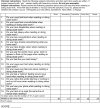Relationship between clinical signs and symptoms of convergence insufficiency
- PMID: 23958713
- PMCID: PMC3929100
- DOI: 10.1097/OPX.0000000000000012
Relationship between clinical signs and symptoms of convergence insufficiency
Abstract
Purpose: The percentage of children who are symptomatic has been shown to increase with the number of signs of convergence insufficiency (CI). Our goal was to investigate whether there is a relationship between the severity of the clinical signs of CI and symptom level reported in children with a three-sign symptomatic CI.
Methods: The Convergence Insufficiency Treatment Trial enrolled 221 children with symptomatic CI from ages 9 to 17 years. Inclusion criteria included the following three signs of CI: (1) exophoria at near at least 4Δ greater than at distance, (2) insufficient positive fusional vergence (PFV) at near, and (3) a receded near point of convergence (NPC) of 6 cm break or greater. The relationships between the severity of each sign of CI (mild, moderate, and severe) and the level of symptoms as measured by the Convergence Insufficiency Symptom Survey (CISS) at baseline were evaluated.
Results: Mean CISS scores were not significantly different between mild, moderate, and severe exophoria (p = 0.60), PFV blur (p = 0.99), Sheard's criterion (p = 0.89), or NPC break (p = 0.84). There was also no difference between the frequency of subjects scoring at mild, moderate, or severe levels on the CISS and the severity of each sign of CI. Correlations between individual clinical signs and the CISS score were very low and not statistically significant.
Conclusions: Among symptomatic children with a CISS score of 16 or higher and three clinical signs of CI, there is no further association between the severity of the clinical signs and their level of symptoms.
Figures
References
-
- Letourneau JE, Lapierre N, Lamont A. The relationship between convergence insufficiency and school achievement. Am J Optom Physiol Opt. 1979;56:18–22. - PubMed
-
- Letourneau J, Ducic S. Prevalence of convergence insufficiency among elementary school children. Can J Optom. 1988;50:194–7.
-
- Rouse MW, Borsting E, Hyman L, Hussein M, Cotter SA, Flynn M, Scheiman M, Gallaway M, De Land PN. Frequency of convergence insufficiency among fifth and sixth graders. The Convergence Insufficiency and Reading Study (CIRS) group. Optom Vis Sci. 1999;76:643–9. - PubMed
-
- Rouse MW, Hyman L, Hussein M, Solan H. Frequency of convergence insufficiency in optometry clinic settings. Convergence Insufficiency and Reading Study (CIRS) Group. Optom Vis Sci. 1998;75:88–96. - PubMed
-
- Borsting E, Rouse MW, Deland PN, Hovett S, Kimura D, Park M, Stephens B. Association of symptoms and convergence and accommodative insufficiency in school-age children. Optometry. 2003;74:25–34. - PubMed
Publication types
MeSH terms
Grants and funding
- EY014710/EY/NEI NIH HHS/United States
- U10 EY014709/EY/NEI NIH HHS/United States
- EY014659/EY/NEI NIH HHS/United States
- U10 EY014715/EY/NEI NIH HHS/United States
- EY014709/EY/NEI NIH HHS/United States
- U10 EY014710/EY/NEI NIH HHS/United States
- EY014713/EY/NEI NIH HHS/United States
- U10 EY014659/EY/NEI NIH HHS/United States
- EY014715/EY/NEI NIH HHS/United States
- U10 EY014712/EY/NEI NIH HHS/United States
- EY014712/EY/NEI NIH HHS/United States
- U10 EY014676/EY/NEI NIH HHS/United States
- U10 EY014706/EY/NEI NIH HHS/United States
- U10 EY014713/EY/NEI NIH HHS/United States
- EY014676/EY/NEI NIH HHS/United States
- EY014706/EY/NEI NIH HHS/United States
- EY014716/EY/NEI NIH HHS/United States
- U10 EY014716/EY/NEI NIH HHS/United States
LinkOut - more resources
Full Text Sources
Other Literature Sources
Medical





